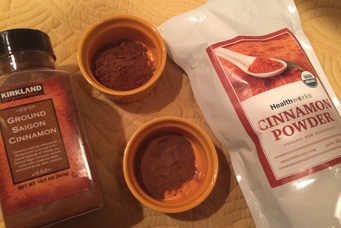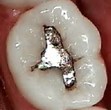
The debate over cinnamon, which is usually Ceylon vs. Saigon, can be confusing. The benefits are the same and your body loves both. Use it for inflammation, fighting cancer, balancing blood sugar and controlling candida. The two most popular varieties of cinnamon are Ceylon cinnamon and Saigon cinnamon. The cost of Ceylon cinnamon is about twice what you will pay for Saigon cinnamon. They are both healing. They are both antimicrobials antioxidants that are inflammation fighters, cancer deterrents and will balance blood sugar while assist the body in a number of ways. It is agreed that "true" cinnamon is that which comes from the bark of the cinnamomum zeylanicum tree. It has a more mild flavor, a lighter color and is sold as Ceylon cinnamon. This is not the most common variety. Saigon cinnamon is actually from the cinnamomum cassia plant and is also called cassia or Chinese cinnamon. It is a darker color with more intense flavor. This is the cinnamon that is most familiar and most popular due to price. The debate takes shape over coumarin, which is a natural blood thinner that is present in Saigon cinnamon. If one was taking pharmaceutical blood thinners they might be instructed to eliminate cinnamon from their diet. In reality, they might need to eliminate Saigon cinnamon and could most likely use Ceylon cinnamon which does not have the blood thinning property. 
Giving up aluminum laden anti-perspirants in favor of cleaner products will take out a chunk of your daily toxic load immediately.
Aluminum is a ubiquitous material, found in our soil, air and water supplies naturally. That does not mean it is good for your body. In fact, we know with certainty that aluminum leaves a trail of illness.
The problem is that aluminum has now infiltrated manufacturing, vaccines, medicines, antacids, antiperspirant, cosmetics and our food supply via processing, frozen meal trays, foil and cans. With so much casual access to sources of aluminum, we need to take a look at our exposure and limit what we can limit. Problem #1 is antiperspirant. All antiperspirants contains aluminum, a known neurotoxin. You faithfully apply it to your underarm which houses your lymph nodes giving easy access to your circulatory system. Your skin absorbs the aluminum along with the product and any other chemicals it holds. When there is more toxicity than the body can safely detox, it will be stored in the body which is a recipe for illness somewhere is your future. The quick fix is easy. Just stop using antiperspirant, but the change is not seamless. We've gotten used to being sweat-free and deodorant just will not do what a toxic product can do when it comes to keeping you dry, so you have to choose. If you can get used to sweating naturally a homemade deodorant will keep you odor free and that is a really easy start to cleaning up your body. Homemade Deodorant Recipe 1 part Baking Soda 1 part Corn Starch, GMO-free Essential oil to scent, if desired Mix completely and store in a glass jar. You can apply with a generous brush or use a shaker top. 
Chronic illness takes on many forms. It has strange symptoms that are in constant motion and forever changing. The symptoms are so illusive that most people just don't believe a chronically ill person is anything more than depressed.
To make matters worse, it is almost impossible to get an exact diagnosis. The chronically ill are tossed into categories like fibromyalgia and the true cause of issues are rarely sought out by traditional medicine. I have 30 years of experience being chronically ill and am curing myself from mercury poisoning, heavy metals toxicity, chronic pain, thyroid issues, candida and leaky gut. It was not an easy road to travel and there were more setbacks than I care to remember, but I have learned a thing or two about what makes my body tick. There some essential things a sick person must do. The first of these would be to access their diet and clean it up. Getting the sugar and white flour is a must if you seek wellness. The next thing I would do is assess the gut. I would recommend candida testing at home with the simple test you can find on this site at http://www.searchforthecausenotjustthecure.com/blog/candida-testing-at-home. Keeping the gut happy will clear up bowel issues, fungal infections and prevent leaky gut from developing. It can also be the source of inflammation, brain fog, fatigue, pain and many other symptoms. Next I would look to the mouth. Any mouth infection, even if it just manifests as a slight gum tenderness, can cause you all of the symptoms you recognize as chronic fatigue. If you are storing mercury in your teeth, via silver fillings, these fillings must be removed by a biologic dentist. A serious look at dental implants and root canals must also be assessed as they can harbor bacteria. The symptoms may not feel like mouth pain, but can cause the symptoms you recognize with chronic pain. A gut and mouth that are unhappy are enough to cause decades of illness that is mysterious, continuous, debilitating and probably misdiagnosed. Most people are reticent to look into the gut or dental issues because traditional medicine ignores them. This means stepping outside the box and possibly accepting ridicule while going against your doctor's advice. The unfortunate truth is that most Western doctors have no idea how to heal a gut issue or how to deal with mercury toxicity. Instead they find themselves more comfortable diagnosing problems as popular, "designer" diseases that have an accompanying line of pharmaceuticals. These drugs will mask the symptoms and trick your body into testing more appropriately, but they do not cure chronic illness. If you take on these drugs instead of searching for the cause, you may never get well. This short video on mercury will give you an idea of how similar the symptoms of your chronic pain and fatigue are aligned with mercury poisoning. One might say no to investigating mercury as a source of their problems believing they have fibromyalgia, Multiple Sclerosis, Lupus or another disease. What you will see in the film is that ALL THE SYMPTOMS ARE THE SAME! It makes no sense not to investigate the possibility of metals as your source of illness when they provide such similar symptoms.
Click to set custom
 This is a dental implant. Although this particular implant is a peculiar design, more common types have wide-spread use. What is not usually known about dental implants is that they have the ability to harbor bacteria which can cause symptoms of illness. When bacteria causes infection, the trouble these diseased implants cause is rarely associated with the implant. A diagnosis that does not connect the dots between symptoms and the infection provides a misdiagnosis, allowing the source of the infection to continue. Warning signs of implant trouble can be non-existant, slight or obvious. You might only notice a sensitivity or a change in the pink color near the gum line of the tooth. It may be the kind of distraction or pain that you can live with easily and do nothing about for a very long time. As usual, pain is the voice of your body. It always has a source. When you search for the cause of illness, consider your teeth, dental implants, silver fillings and root canals as potential sources. This implant caused a low-grade irritation that seemed meaningless in comparison to other physical complaints that were not seemingly associated with the tooth. There was joint pain with constant inflammation plus a debilitating pain in the hip that made daily movement limited. The decision to manage the tooth was secondary to what were considered more demanding issues in the body. When the tooth was finally identified as a potential problem, there was no absolute certainty. The decision to remove it came with no guarantee that it was the source of the tender gum or the signs of minor infection and dull pain. In the end, after removal, the tooth was able to be identified as the connection to most of the issues. Within 24 hours of removal the body began to heal. The changes were dramatic. The hip pain was gone by morning, never to return. The infection, which was obvious after removal, began to dissipate. Vitality and strength returned to a body that had been depleted by this on-going, low-grade infection. The mouth is rarely considered in times of illness. We tend to treat symptoms and never search for the cause of pain. Once symptoms are put in check with drugs, we usually move on without having addressed the true issue. Meanwhile the source remains active. When you search for the cause of long-term illness, chronic fatigue, inflammation, chronic pain, lethargy, join pain, anxiety, cognative disorders, ADHD, Multiple Sclerosis, ALS, Alzheimer's, Parkinson's and more, consider the mouth and dental health. To be treated correctly and to receive the most current protocol, which will conflict with the American Dental Association's view at times, you will need a biologic dentist. For sources of biologic dentists visit www.IAOMT.org. Note: If you have "silver" fillings, which are more appropriately known as, mercury amalgam fillings, please learn more about them on this site at: http://www.searchforthecausenotjustthecure.com/strike-out-mercury-information-and-registration-form.html  Silver fillings are actually mostly mercury. The are the preferred material for dental insurance companies for one reason only, they are cheap. The dangers are no secret, yet the practice continues. Consumers believe that an insurance company and an association of dentists would not and could not, promote something so dangerous, but they have and do. Patients who have their mercury amalgam fillings removed sometimes report instant recover and signs of healing. Debilitating pains from hips and knees can be gone forever within days, symptoms of chronic illness, multiple sclerosis, fibromyalgia, lupus, Parkinson's and many other conditions can also disappear. Others heal more slowly or don't notice healing. For some there is improvement, but permanent damage can cause symptoms to persist. Using your mouth to store one of the most toxic chemicals on earth is a really bad idea. 
The following article is taken from the Breast Cancer Action website. If you want to understand what Pink Ribbon Campaigns are actually doing, read on and refuse to be part of the fearful who follow because Big Pharma says you should.
4 Questions Before You Buy PinkPinkwashingBreast Cancer Action coined the term pinkwashing as part of our Think Before You Pink® campaign. Pinkwasher: (pink’-wah-sher) noun. A company or organization that claims to care about breast cancer by promoting a pink ribbon product, but at the same time produces, manufactures and/or sells products that are linked to the disease.Critical Questions to Ask Before You Buy Pink
1. Does any money from this purchase go to support breast cancer programs? How much? Any company can put a pink ribbon on its products. The widely recognized pink ribbon symbol is not regulated by any agency and does not necessarily mean it effectively combats the breast cancer epidemic. Some products sport pink ribbons to try to communicate that they are “healthy” and don’t contribute to breast cancer, such as a number of natural health and beauty products. Other products have a pink ribbon in order to indicate that the company supports breast cancer programs even if the company’s contributions are not tied to the purchases of the specific product bearing the ribbon. Still other companies give a portion of an item’s cost to a breast cancer organization but may require further action on the part of the consumer for the donation to be realized. Can you tell how much money from your purchases will go to support breast cancer programs? If not, consider giving directly to the charity of your choice instead. EXAMPLE: In 2010, Dansko shoe company sold pink ribbon clogs. Consumers likely thought that a portion of their purchase of pink ribbon clogs went to a breast cancer program. However, purchase of the pink ribbon clogs was not connected to Dansko’s donation—none of the portion of the sales went toward their already set donation of $25,000 to Susan G. Komen for the Cure. No matter whether or not you bought the clogs, their donation was the same. 2. What organization will get the money? What will they do with the funds, and how do these programs turn the tide of the breast cancer epidemic?Many companies that sell pink ribbon products and donate a percentage of each sale to breast cancer programs fail to indicate which of the many different breast cancer organizations will get the money. Furthermore, the consumer is left to trust that these organizations are engaged in work that is meaningful and makes the greatest difference. If money goes to “services,” are they reaching the people who need them most? How do screening programs ensure that women can get treatment? And how do breast cancer awareness programs address the fact that we already know that breast cancer is a problem and that action is needed in order to end the epidemic? Does the money go to truly addressing the root causes of the epidemic, like social inequities that lead to women of color and poor women dying more often of breast cancer, or environmental toxins that are contributing to high rates of breast cancer? Before donating, check the recipient organization’s website to make sure that its mission and activities are in line with your personal values. If you can’t tell, or you don’t know what the organization does, reconsider your purchase. EXAMPLE: The KISSES for a Cure music box is advertised by its maker, The Bradford Exchange, online with the following: “A portion of the proceeds from this music box will be donated to help fight breast cancer.” It is not clear what breast cancer organizations would benefit, how much money they would receive, and what programs or work would be funded by the donation. 3. Is there a “cap” on the amount the company will donate? Has this maximum donation already been met? Can you tell?Some companies that indicate that a portion of the proceeds from the sale of a particular pink ribbon product will go to support breast cancer programs put an arbitrary “cap” on their maximum donation. Once the maximum amount has been met, the company may continue to sell the product with the pink ribbon without alerting customers that no additional funds will be donated to breast cancer organizations. This means you may be buying a product for which none of your purchase price will go to a breast cancer cause but only to the bottom line of the company. EXAMPLE: In 2010, Reebok marketed a line of pink ribbon emblazoned footwear and apparel at prices ranging from$50 to $100. Though it heavily promoted the fact that some of their pink ribbon product sales would be donated tothe Avon Breast Cancer Crusade, they set a limit of $750,000, regardless of how many items were sold, and therewas no mechanism in place to alert consumers once the maximum donation had been met. 4. Does this purchase put you or someone you love at risk for exposure to toxins linked to breast cancer? What is the company doing to ensure that its products are not contributing to the breastcancer epidemic?Many companies have sold pink ribbon products that are linked to increased risk of breast cancer. We believe that companies that are profiting from building a reputation based on their concern about breast cancer have a responsibilityto protect the public from possible harms when scientifi c research indicates that there is a risk or plausible reason forconcern. Some of the earliest cause-marketing companies were well-known cosmetics companies that continue to sell cosmetics containing chemicals that have been linked to breast cancer. Even car companies have gotten in on the action and sell cars that emit toxic air pollutants in the name of breast cancer. In considering a pink ribbon purchase, does the product contain toxins or otherwise increase our risk of breast cancer? EXAMPLE: In 2011, Susan G. Komen for the Cure commissioned a perfume called Promise Me that contains unlisted chemicals that are regulated as toxic and hazardous, have not been adequately evaluated for human safety, and have demonstrated negative health effects. Although Komen said they would reformulate future versions of the perfume, without official adoption of the precautionary principle, there is no guarantee that future versions would be better. |
AuthorSusan Trump Archives
July 2024
Categories
All
|

